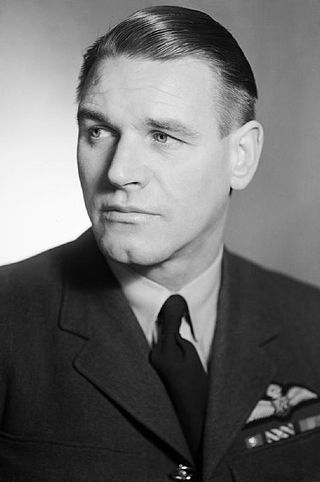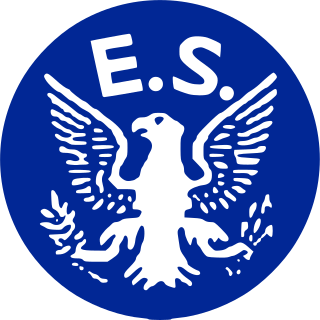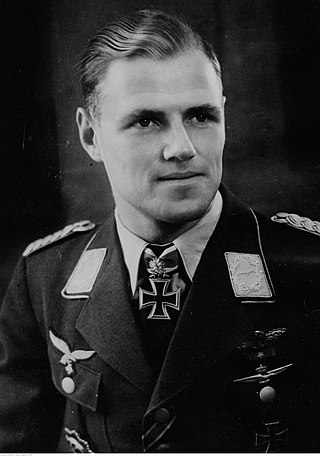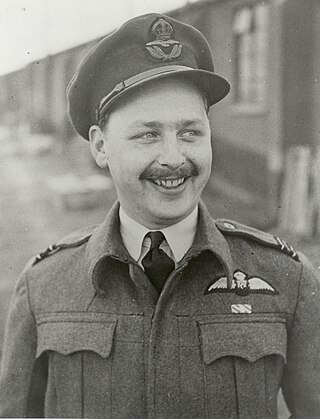Related Research Articles

George Frederick "Buzz" Beurling, was the most successful Canadian fighter pilot and flying ace of the Second World War.

Adolph Gysbert Malan,, better known as Sailor Malan, was a South African fighter pilot and flying ace in the Royal Air Force (RAF) who led No. 74 Squadron RAF during the Battle of Britain. He finished his fighter career in 1941 with twenty-seven destroyed, seven shared destroyed and two unconfirmed, three probables and sixteen damaged. At the time he was the RAF's leading ace, and one of the highest scoring pilots to have served wholly with RAF Fighter Command during the Second World War.

The Eagle Squadrons were three fighter squadrons of the Royal Air Force (RAF) formed with volunteer pilots from the United States during the early days of World War II, prior to America's entry into the war in December 1941.

Wing Commander Lance Cleo "Wildcat" Wade DSO, DFC & Two Bars was an American pilot who joined the Royal Air Force (RAF) during the Second World War and became a flying ace. He remained with RAF until his death in a flying accident in 1944 in Italy. He was described as a "distinguished American fighter ace who epitomized perhaps more than any other American airman the wartime accords between Britain and the United States".

James Francis Edwards, CM, DFC & Bar, DFM, CD, later known as Stocky Edwards, was a Canadian fighter pilot during World War II. With 19 confirmed aerial victories, Edwards was Canada's highest scoring ace in the Western Desert Campaign.
Neville Frederick Duke, was a British test pilot and fighter ace of the Second World War. He was credited with the destruction of 27 enemy aircraft. After the war, Duke was acknowledged as one of the world's foremost test pilots. In 1953, he became holder of the world air speed record when he flew a Hawker Hunter at 727.63 mph (1,171.01 km/h) over Littlehampton.

Joachim Müncheberg was a German Luftwaffe fighter pilot during World War II and an ace credited with 135 air victories. The majority of his victories were claimed over the Western Front, with 33 claims over the Eastern Front. Of his 102 aerial victories achieved over the Western Allies, 46 were against Supermarine Spitfire fighters.

Group Captain Billy Drake, was a British fighter pilot and air ace. He was credited officially with 18 enemy aircraft destroyed, two shared, two unconfirmed, four probables, two shared probables and five damaged and one shared damaged with the Royal Air Force during the Second World War. Further revisions to these statistics increased this total to 20 destroyed and seven damaged with a further 13 destroyed and four damaged on the ground.

Raymond Hiley Harries, was a Royal Air Force fighter pilot and flying ace of the Second World War. Harries scored 15 victories against enemy aircraft, as well as three shared kills, two probable kills and five damaged during the war. Harries is also credited with the destruction of a V-1 flying bomb.
Air Commodore James Rankin, was a Royal Air Force officer, fighter pilot and flying ace of the Second World War.
Maurice Michael Stephens, was a Royal Air Force flying ace of the Second World War. Stephens scored 17 kills, three shared kills, one probable kills and five damaged.

Furio Niclot Doglio, MOVM was an Italian test pilot and World War II fighter pilot in the Regia Aeronautica. Doglio set nine world aviation records in the 1930s during his time as a test pilot. During the war, he claimed seven kills, flying FIAT G. 50s and Macchi C. 202s, establishing himself as one of Italy's aces. Doglio was killed in combat on 27 July 1942 during the Siege of Malta by George Beurling, who became Canada's top ace of the war. He was awarded a Medaglia d'oro al Valor Militare alla memoria.

John Connell Freeborn, was a fighter pilot and flying ace in the Royal Air Force (RAF) during the Second World War.
Franco Lucchini, MOVM, was an Italian World War II fighter pilot in the Aviazione Legionaria and in the Regia Aeronautica. During World War II he achieved 21 individual air victories, plus 52 shared, to add to the five kills in Spain, during the Civil War.

Ioannis Agorastos "John" Plagis, DSO, DFC & Bar (1919–1974) was a Southern Rhodesian flying ace in the Royal Air Force (RAF) during the Second World War, noted especially for his part in the defence of Malta during 1942. The son of Greek immigrants, he was accepted by recruiters only after Greece joined the Allies in late 1940. Following spells with No. 65 Squadron and No. 266 (Rhodesia) Squadron, he joined No. 249 Squadron in Malta in March 1942. Flying Spitfire Mk Vs, Plagis was part of the multinational group of Allied pilots that successfully defended the strategically important island against numerically superior Axis forces over the next few months. Flying with No. 185 Squadron from early June, he was withdrawn to England in early July 1942.
Anthony Desmond Joseph Lovell, was a fighter pilot and flying ace of the Royal Air Force during the Second World War. He served in the Battle of Britain, on Malta, and over France, but was killed in a flying accident shortly after the war in Europe had ended.
Andrew Bosman was a South African flying ace of World War II, scoring 10½ kills.

Douglas William Golding is a South African flying ace of World War II, credited with 3 'kills'.

Brian John Lister Boyle, DFC (1917-1993) was a South African flying ace of World War II, credited with 5 'kills'.
William Thomas Edward Rolls was a British flying ace of the Royal Air Force Volunteer Reserve (RAFVR) during the Second World War. He was credited with the destruction of at least 17 aircraft of the Axis powers.
References
- 1 2 3 4 Shores, C; Williams C (15 July 2008). Aces High: A Tribute to the Most Notable Fighter Pilots. Grub Street. ISBN 978-1-898697-00-8.
- ↑ Thomas, Andrew (2011). Spitfire Aces of North Africa and Italy. Osprey. ISBN 978-1849083430.